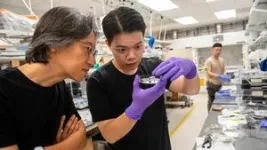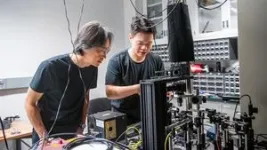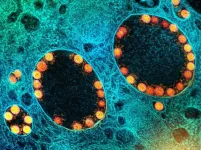(Press-News.org) LA JOLLA (August 11, 2023)—Glioblastoma, the most common and deadly form of brain cancer, grows rapidly to invade and destroy healthy brain tissue. The tumor sends out cancerous tendrils into the brain that make surgical tumor removal extremely difficult or impossible.
Now, Salk scientists have found the immunotherapy treatment anti-CTLA-4 leads to considerably greater survival of mice with glioblastoma. Furthermore, they discovered that this therapy was dependent on immune cells called CD4+ T cells infiltrating the brain and triggering the tumor-destructive activities of other immune cells called microglia, which permanently reside in the brain.
Published in Immunity on August 11, 2023, the findings show the benefit of harnessing the body’s own immune cells to fight brain cancer and could lead to more effective immunotherapies for treating brain cancer in humans.
“There are currently no effective treatments for glioblastoma—a diagnosis today is basically a death sentence,” says Professor Susan Kaech, senior author and director of the NOMIS Center for Immunobiology and Microbial Pathogenesis. “We’re extremely excited to find an immunotherapy regimen that uses the mouse’s own immune cells to fight the brain cancer and leads to considerable shrinkage, and in some cases elimination, of the tumor.”
When standard cancer treatments like surgery, chemotherapy, and radiation cease to be effective, doctors increasingly turn to immunotherapy. Immunotherapy encourages the body’s own immune cells to seek and destroy cancer cells. Though not universal, immunotherapy works on many tumors and has provided many patients with strong, long lasting anti-cancer responses. Kaech wanted to find new ways of harnessing the immune system to develop more safe and durable treatments for brain cancer.
Her team found three cancer-fighting tools that have been somewhat overlooked in brain cancer research that may cooperate and effectively attack glioblastoma: an immunotherapy drug called anti-CTLA-4 and specialized immune cells called CD4+ T cells and microglia.
Anti-CTLA-4 immunotherapy works by blocking cells from making the CTLA-4 protein, which, if not blocked, inhibits T cell activity. It was the first immunotherapy drug designed to stimulate our immune system to fight cancer, but it was quickly followed by another, anti-PD-1, that was less toxic and became more widely used. Whether anti-CTLA-4 is an effective treatment for glioblastoma remains unknown since anti-PD-1 took precedence in clinical trials. Unfortunately, anti-PD-1 was found to be ineffective in multiple clinical trials for glioblastoma—a failure that inspired Kaech to see whether anti-CTLA-4 would be any different.
As for the specialized immune cells, CD4+ T cells are often overlooked in cancer research in favor of a similar immune cell, the CD8+ T cell, because CD8+ T cells are known to directly kill cancer cells. Microglia live in the brain full time, where they patrol for invaders and respond to damage—whether they play any role in tumor death was not clear.
First, the researchers compared the life spans of mice with glioblastoma when treated with anti-CTLA-4 versus anti-PD-1. After discovering that blocking CTLA-4 prolonged their life spans considerably, but blocking PD-1 did not, the team moved on to figure out what made that outcome possible.
They found that after anti-CTLA-4 treatment, CD4+ T cells secreted a protein called interferon gamma that caused the tumor to throw up “stress flags” while simultaneously alerting microglia to start eating up those stressed tumor cells. As they gobbled up the tumor cells, the microglia would present scraps of tumor on their surface to keep the CD4+ T cells attentive and producing more interferon gamma—creating a cycle that repeats until the tumor is destroyed.
“Our study demonstrates the promise of anti-CTLA-4 and outlines a novel process where CD4+ T cells and other brain-resident immune cells team up to kill cancerous cells,” says co-first author Dan Chen, a postdoctoral researcher in Kaech’s lab.
To understand the role of microglia in this cycle, the researchers collaborated with co-author and Salk Professor Greg Lemke, holder of the Françoise Gilot-Salk Chair. For decades, Lemke has investigated critical molecules, called TAM receptors, used by microglia to send and receive crucial messages. The researchers found that TAM receptors told microglia to gobble up cancer cells in this novel cycle.
“We were stunned by this novel codependency between microglia and CD4+ T cells,” says co-first author Siva Karthik Varanasi, a postdoctoral researcher in Kaech’s lab. “We are already excited about so many new biological questions and therapeutic solutions that could radically change treatment for deadly cancers like glioblastoma.”
Connecting the pieces of this cancer-killing puzzle brings researchers closer than ever to understanding and treating glioblastoma.
“We can now reimagine glioblastoma treatment by trying to turn the local microglia that surround brain tumors into tumor killers,” says Kaech, holder of the NOMIS Chair. “Developing a partnership between CD4+ T cells and microglia is creating a new type of productive immune response that we have not previously known about.”
Next, the researchers will examine whether this cancer-killing cell cycle is present in human glioblastoma cases. Additionally, they aim to look at other animal models with differing glioblastoma subtypes, expanding their understanding of the disease and optimal treatments.
Other authors include Toshiro Hara, Kacie Traina, Ming Sun, Bryan McDonald, Yagmur Farsakoglu, Josh Clanton, Shihao Xu, Lizmarie Garcia-Rivera, Thomas H. Mann, Victor Du, H. Kay Chung, Ziyan Xu, Victoria Tripple, Eduardo Casillas, Shixin Ma, Carolyn O’Connor, Qiyuan Yang, Ye Zheng, and Tony Hunter of Salk.
The work was supported by the National Institutes of Health (CA195613), Cancer Research Institute, Damon Runyon Cancer Research Foundation, and a National Cancer Center fellowship.
About the Salk Institute for Biological Studies:
Unlocking the secrets of life itself is the driving force behind the Salk Institute. Our team of world-class, award-winning scientists pushes the boundaries of knowledge in areas such as neuroscience, cancer research, aging, immunobiology, plant biology, computational biology, and more. Founded by Jonas Salk, developer of the first safe and effective polio vaccine, the Institute is an independent, nonprofit research organization and architectural landmark: small by choice, intimate by nature, and fearless in the face of any challenge. Learn more at www.salk.edu.
END
Using the body’s “invisible scalpel” to remove brain cancer
Salk scientists find immunotherapy anti-CTLA-4 extends life of mice with glioblastoma and discover new way cells kill cancer
2023-08-11
ELSE PRESS RELEASES FROM THIS DATE:
Playing football may increase the risk for Parkinson’s disease
2023-08-11
(Boston)—Identification of risk factors for Parkinson’s disease (PD) is essential for early diagnosis. Dating back to the 1920s, Parkinson’s disease and parkinsonism—an umbrella term that refers to motor symptoms found in Parkinson’s disease and also other conditions—have long been described in boxers. Repetitive head impacts from tackle football can also have long-term neurological consequences like chronic traumatic encephalopathy (CTE). But research on the association between participation in tackle football and PD is limited.
In the largest study to describe the association between participation ...
Perceptions of safety of daily cannabis vs tobacco smoking and secondhand smoke exposure
2023-08-11
About The Study: This survey study of 5,035 adults found that adults increasingly perceived daily smoking and secondhand exposure to cannabis smoke as safer than tobacco smoke from 2017 to 2021. Given that these views do not reflect the existing science on cannabis and tobacco smoke, the findings may have important implications for public health and policy as the legalization and use of cannabis increase.
Authors: Beth Cohen, M.D., M.A.S., of the University of California, San Francisco, is the corresponding author.
To access the embargoed study: Visit our For The Media website at this link https://media.jamanetwork.com/
(doi:10.1001/jamanetworkopen.2023.28691)
Editor’s ...
Gestational age and birth outcomes in term singleton pregnancies conceived with infertility treatment
2023-08-11
About The Study: The results of this study suggest that, in pregnancies conceived with infertility treatment, delivery at 39 weeks provided the lowest perinatal risk when comparing risk of delivery at this week of gestation versus the subsequent week of gestation.
Authors: Ira Hamilton, M.D., of the University of Cincinnati College of Medicine in Cincinnati, is the corresponding author.
To access the embargoed study: Visit our For The Media website at this link https://media.jamanetwork.com/
(doi:10.1001/jamanetworkopen.2023.28335)
Editor’s ...
Football participation and Parkinson disease among men
2023-08-11
About The Study: In this study, 729 participants with a history of playing organized football had higher odds of having a reported parkinsonism or Parkinson disease diagnosis compared with participants in other organized sports. Longer duration of play and higher level of football play were associated with higher odds of a reported diagnosis.
Authors: Michael L. Alosco, Ph.D., of the Boston University Chobanian & Avedisian School of Medicine in Boston, is the corresponding author.
To access the embargoed study: Visit our For The Media website at this link https://media.jamanetwork.com/
(doi:10.1001/jamanetworkopen.2023.28644)
Editor’s ...
Association of caregiver depression risk with patient outcomes in Parkinson disease
2023-08-11
About The Study: Patients with Parkinson disease who had caregivers at higher risk of depression were more likely to have worse quality of life and higher emergency department use than patients who had caregivers not at higher risk of depression. Additional caregiving resources and interventions to reduce caregiver depression symptoms could potentially improve patient outcomes.
Authors: Nabila Dahodwala, M.D., M.S., of the Perelman School of Medicine at the University of Pennsylvania in Philadelphia, is the corresponding author.
To access the embargoed study: Visit our For The Media website at this link https://media.jamanetwork.com/
(doi:10.1001/jamanetworkopen.2023.27485)
Editor’s ...
De-code of the crop
2023-08-11
A research group led by Kyoto University's Graduate School of Agriculture has deciphered buckwheat's high-precision chromosomal-level genome sequence, a key step toward unraveling the evolution of the buckwheat genome and the origins of the cultivated crop.
By altering specific genes using a method independent of common genome-editing techniques,
the researchers successfully developed a self-fertile buckwheat variety as well as a new type of the crop with a sticky, mochi-like texture. This breeding method may contribute to a more diverse range of orphan crops than what is possible with existing genome editing technologies.
With the world's population predicted to reach ...
More than 2 million additional Americans faced food insufficiency following drawdown of pandemic-related SNAP benefits, Penn Medicine study finds
2023-08-11
PHILADELPHIA— The recent discontinuation of pandemic-related food assistance benefits, known as the Supplemental Food Assistance Program (SNAP) Emergency Allotments, led to a substantial increase in food insufficiency in the United States, according to a new study led by researchers at the Perelman School of Medicine at the University of Pennsylvania. The primary goal of SNAP, which distributes cash-like benefits to low-income families to buy food, is to combat food insecurity, which affects 10 percent of U.S. households. The findings were published in JAMA Health Forum today.
Comparing trends in food insufficiency ...
COVID-19 vaccination and boosting during pregnancy benefits pregnant people and newborns
2023-08-11
WHAT:
Receiving a COVID-19 mRNA vaccine or booster during pregnancy can benefit pregnant people and their newborn infants, according to findings recently published in Vaccine. The paper describes results from the Multisite Observational Maternal and Infant Study for COVID-19 (MOMI-VAX), which was funded by the National Institute of Allergy and Infectious Diseases (NIAID), part of the National Institutes of Health.
The MOMI-VAX study launched in June 2021 when data on COVID-19 vaccination in pregnant people were sparse. Researchers hoped to understand the ...
Evolving elegance: TU Dresden scientists connect beauty and safeguarding in ammonoid shells
2023-08-11
Ammonoids are a group of extinct marine mollusk animals that are now an iconic fossil group often collected by amateurs. Over 350 million years of evolution, ammonoids developed increasingly elaborate shells with fractal-like geometry. For nearly 200 years, scientists have debated the reason why these animals show a trend of increasing complexity in their shell structures. Dr. Robert Lemanis and Dr. Igor Zlotnikov from the B CUBE – Center for Molecular Bioengineering at TU Dresden created mechanical simulations of theoretical and computed tomography-based models to unveil a potential explanation: the intricate architecture of these shells may have been nature's ingenious ...
Researchers “film” novel catalyst at work
2023-08-11
A novel catalysis scheme enables chemical reactions that were previously virtually impossible. The method developed at the University of Bonn is also environmentally friendly and does not require rare and precious metals. The researchers recorded the exact course of the catalysis in a kind of high-speed film. They did this using special lasers that can make processes visible that last only fractions of a billionth of a second. The results allow them to further optimize the catalyst. They have been published in the international edition of the renowned journal Angewandte Chemie.
Let’s say you are playing mini ...
LAST 30 PRESS RELEASES:
Injectable breast ‘implant’ offers alternative to traditional surgeries
Neuroscientists devise formulas to measure multilingualism
New prostate cancer trial seeks to reduce toxicity without sacrificing efficacy
Geometry shapes life
A CRISPR screen reveals many previously unrecognized genes required for brain development and a new neurodevelopmental disorder
Hot flush treatment has anti-breast cancer activity, study finds
Securing AI systems against growing cybersecurity threats
Longest observation of an active solar region
Why nail-biting, procrastination and other self-sabotaging behaviors are rooted in survival instincts
Regional variations in mechanical properties of porcine leptomeninges
Artificial empathy in therapy and healthcare: advancements in interpersonal interaction technologies
Why some brains switch gears more efficiently than others
UVA’s Jundong Li wins ICDM’S 2025 Tao Li Award for data mining, machine learning
UVA’s low-power, high-performance computer power player Mircea Stan earns National Academy of Inventors fellowship
Not playing by the rules: USU researcher explores filamentous algae dynamics in rivers
Do our body clocks influence our risk of dementia?
Anthropologists offer new evidence of bipedalism in long-debated fossil discovery
Safer receipt paper from wood
Dosage-sensitive genes suggest no whole-genome duplications in ancestral angiosperm
First ancient human herpesvirus genomes document their deep history with humans
Why Some Bacteria Survive Antibiotics and How to Stop Them - New study reveals that bacteria can survive antibiotic treatment through two fundamentally different “shutdown modes”
UCLA study links scar healing to dangerous placenta condition
CHANGE-seq-BE finds off-target changes in the genome from base editors
The Journal of Nuclear Medicine Ahead-of-Print Tip Sheet: January 2, 2026
Delayed or absent first dose of measles, mumps, and rubella vaccination
Trends in US preterm birth rates by household income and race and ethnicity
Study identifies potential biomarker linked to progression and brain inflammation in multiple sclerosis
Many mothers in Norway do not show up for postnatal check-ups
Researchers want to find out why quick clay is so unstable
Superradiant spins show teamwork at the quantum scale
[Press-News.org] Using the body’s “invisible scalpel” to remove brain cancerSalk scientists find immunotherapy anti-CTLA-4 extends life of mice with glioblastoma and discover new way cells kill cancer






